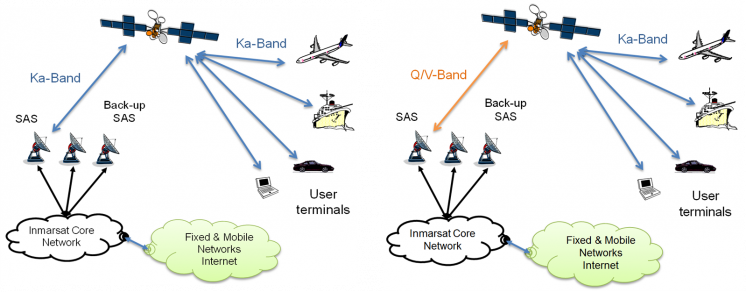-
StatusCompleted
-
Status date2016-09-01
-
Activity Code1B.076
The main objective is to define the technology roadmaps that need to be implemented by the European and Canadian industry players to be able to deploy Next Generation MSS systems
- within the 2018 time frame for benchmark L-band MSS systems, and beyond for the advanced system
- within the 2025 time frame for benchmark Ka-band MSS systems, and beyond for the advanced system
To this end, the team has analysed two future global MSS systems, one in the L-band, one in the Ka-band, as the next generation of the Inmarsat 5 Global-Xpress system.
The logic of the study was to initially design two reference or benchmark systems using available and qualified technologies, then to analyse the ways to improve these systems. For the L-band system, the objective was to reduce cost while preserving the performances. For the Ka-band system, the intention was to increase the system throughput while keeping the same satellite class. For the two frequency bands, two advanced systems are designed using different technologies mixes. The analysis of the performances and improvements allow choosing one of the two advanced systems to establish the roadmaps. For each system, two architectures have been proposed, except for the benchmark Ka band system, with a single architecture.
(The above is a sample picture)
The main challenges for the project were the following. First for the benchmark system
- Design a system that could be the baseline for the future Global L band MSS,
- Optimize the antenna design in order to provide around 100 spot beams, and with a maximum gain, and a maximum C/I with a four colour scheme
- Design a single Ka band architecture system optimizing the spectrum usage for a maximum flexibility
On the advanced systems
- Provide innovative payload architectures for both L and Ka band systems
Increase capacity and provide higher flexibility
The project has allowed to provide different architectures to enable improved Mobile Satellite Systems in both L and Ka band, at different horizons 2018/2025, and beyond.
Different innovative technologies like Ground Based Beam Forming (GBBF), Digital Transparent Processor (DTP), or Broadband Beam Hoping (BBH) are proposed in order to improve capacity and/or flexibility. After a review of the Technology Sate of The Art, each critical technology has been characterized by a list of potential suppliers, and their TRL.
SYSTEM ARCHITECTURE

In L band, the benchmark system is provided on the left, and the advanced system on right.
The system is composed of:
- a Space Segment : 3 GEO satellites at 25°E, 98°W & 143°E.
- a Ground Segment : Satellite Access Stations (SAS) and back-up.
- an User Segment consisting of a fleet of BGAN terminals over the world
For benchmark system, the Payload is using multimatrix architecture with a large deployable reflector. For the advanced system, a GBBF architecture is provided, requiring the use of the Ka band on feeder instead of C-band.

In Ka band, the system is composed of:
- a Space Segment : 3 GEO satellites at 64°E, 55°W & 178°E.
- a Ground Segment : 2 SAS and back-up
- an User Segment consisting of a fleet of terminals
The satellites include two payloads:
- The “Global Payload” (GP) supports the mission of providing two ways Ka-band communication on a fixed multi-beam global coverage.
- The High Capacity Payload (HCP) provides extra capacity through a set of 8 independently steerable beams.
For the benchmark system, fully transparent payload is used.
For the advanced system, the feeder link is using Q/V bands and in the first option, a Transparent Digital Processor is implemented on both links, while for the second option Beam Hoping is implemented on forward link. DRA antennas are used for HCP
The project addresses two different Mobile Satellite Systems, one in L band, the other one in Ka band, as far as user links are concerned.
The coverage is worldwide, and the end user terminals are Laptop type terminals for L band.
The benchmark system in L band takes benefit from Inmarsat 4 and uses C-band for feeder links. A large deployable reflector of 9 m is implemented with the multimatrix architecture. The future platform NEOSAT is foreseen, with rotation of the satellite flight axis to ensure antenna pointing.
The advanced system in L band is using GBBF technology with the SDMA or one beam per user technique. The large amount of required bandwidth in feeder links pushes towards the use of V/Q-band. The capacity is widely increased.
In Ka band, the benchmark system provides 80 spot beams with different bandwidth, and takes also benefit from Inmarsat 5 design.
The advanced system in Ka-band offers two alternatives in the view of increasing flexibility, and they are both implementing Q/V-bands on the feeder links, except for the High Capacity Payload (HCP), steerable beams with their own feeder links in Ka band
- First architecture is based on SDMA with a DTP on both directions
- Second architecture is based on beam hoping on forward link and DTP on the return
- HCP uses DRA antenna.
After the Kick Off Meeting, the different millstones of the project are the following
- RR : Requirement Review, during which, the different technical specifications were reviewed, as well as the Technological State of the Art
- BDR : Benchmark System Design Review : review of the design of the Benchmark systems, and their related performances at the horizon 2018/2025
- ASDR : Advanced System Design Review: review of the design of the Advanced systems, and their related performances at the horizon 2018/2025
- FR : Final Review : Final Review of the Project including Roadmaps presentations
Final Presentation at ESA workshop.
The Final Review has taken place in Toulouse on May 26th 2016, and was successful.






